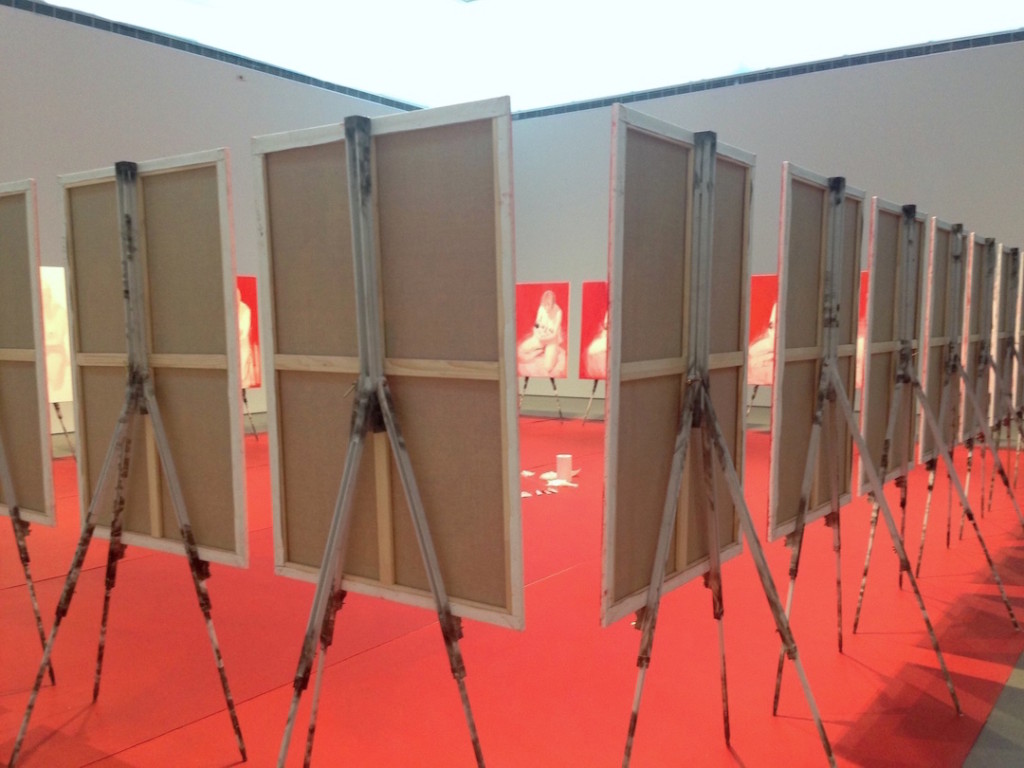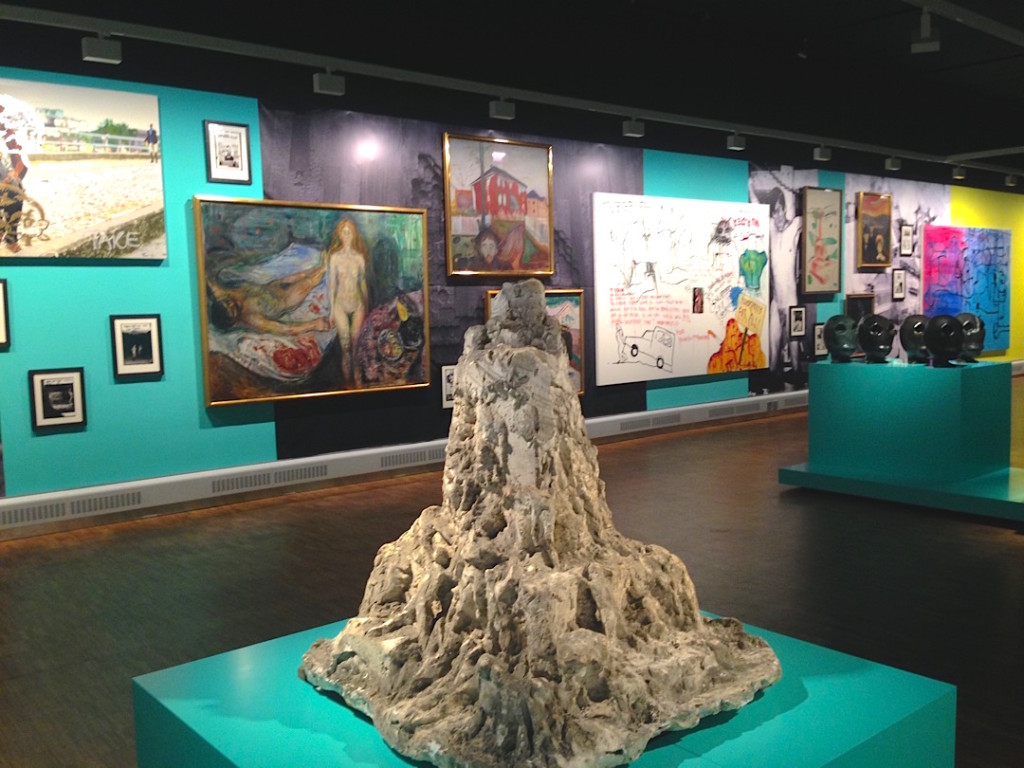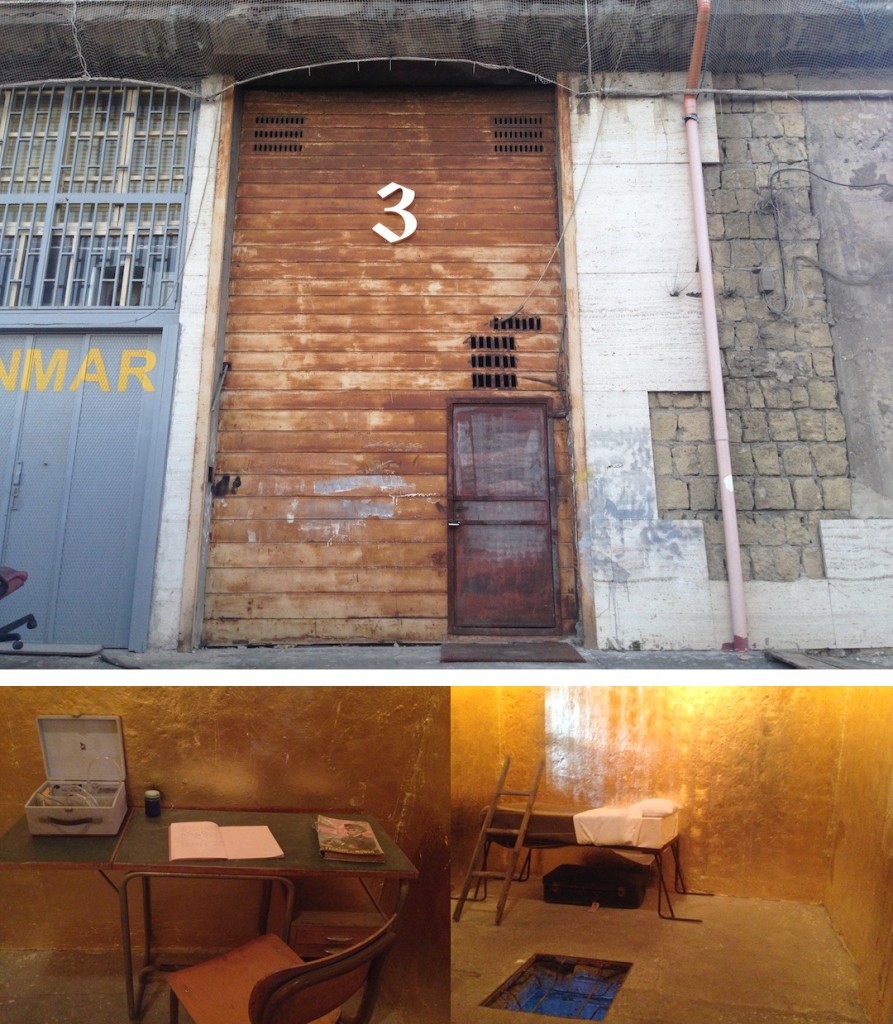
Gian Maria Tosatti, “Lucifero” (2015) Entrance & Installation view, Naples, Italy, Photograph/s by Katy Hamer, 2015
In several abandoned buildings in the heart of Naples, artist Gian Maria Tosatti has been diligently working on a seven part project titled “Sette Stagioni dello Spirito” which commenced in 2013 and continues today although is slated to come to a close in 2016. In english, the title translates as “Seven Stages of the Spirit” and at time of publication, six of the seven parts have been realized. Tosatti, originally from Rome, has been living in Naples in order to complete and create this project. He is represented by Galleria Lia Rumma and has had additional support by the Naples based Fondazione Morra. At the heart of his work is the human spirit. He uses the realm of art to allow those present to access something inside themselves and this is not an easy undertaking. Most of the best art can take your breath away, quicken the beat of one’s heart, and widen the gaze of the eyes, Tosatti does this and more. Having established particular rules, or boundaries if you will, regarding the way the work is to be experienced, viewers are allowed into the installation only one at a time, with the instruction to ‘take as long as you need’. There is freedom in that, a gift of will granted to the visitor regarding the exploration of a previously abandoned residence, now still abandoned but carrying a gem in its belly. In most of the iterations of his practice, there is an element of shock and awe. Usually, this comes from an interior place buried like a forgotten memory and emerges from the heart of the viewer rather than the work itself. With “Lucifero 3” which was open by appointment only, the artist intervened in a huge building sitting parallel to the Port of Naples. On one side, ships come in to dock boarding or relinquishing passengers, the other side faces the city. Located in an industrial quarter, the building is, for lack of a better word, tremendous and the art, what the visitor seeks, is subtly installed throughout. Dispersed over three floors, “Lucifero 3” is tells the loose narrative of the cast out angel and presents a question of ‘what if’ he hadn’t been cast out? Also pondering, what was he like as a child? Tosatti has a way with space and in making the viewer the instigator or rather performer in the world he has made. In much of his work, there is a strong sense of loss and expectancy as he has the ability to make worlds that somehow feel as if we —as viewers— are treading on someone else’s territory. In the silence of the expansive interior, Tosatti allows for a moments of both respite and anxiety as one trudges forward ‘looking’ for what could be identified as out of the ordinary or rather, art. In walking the rooms, we are both implicated and exempt. It’s as if Tosatti raises the dead without ever providing a glimpse of the ghost. Instead it’s his presence we feel that is transferred through the placement of objects, notations of text, repetition of form and most importantly absence. In “Lucifero” a room (former office or storage space) contains an open bottle of wine, a pot of boiling water on a gas stove, a tv playing “It’s a Wonderful Life” and a bedroom with a jacket laid out. Upon entering the first sensation that I had, was “whose life did I just intrude upon?” and “will he be back soon.” Yes, there is a sense of masculinity conveyed through unspoken silence which for anyone having dealt with abandonment from a male figure (uncle, father, grandfather, friend), carries a melancholic strength and odd sense of hope. In another room, tiny window glowing orange, is a miniature bed, a book and notepad with writing and a square shape in the floor, whereas when one looks down, an illuminated blue, cloud filled sky looks back. Tosatti’s “Sette Stagioni dello Spirito” delves into a realm that is hyper-real through sculptural installation using every day objects and the window of each viewer’s mind. Each experience has the power to be unique based on what he or she brings to the table, or in this case room. There are some things that just are and cannot be argued or left up to interpretation. Tosatti siphons the past through an invisible portal, the same one that each viewer steps through upon entering each of his exhibitions. The phantasmagoric dust has yet to settle, and may even continue to haunt, long after you’ve left the venue. It is that element of lingering where the artist succeeds in the realm of art, by entering our minds and hearts he presents his story, which somehow can quickly become our own.
Gian Maria Tosatti, “Sette Stagioni dello Spirito” is an ongoing project which commenced in 2013 and will come to a close in 2016. He has many other projects and will have an upcoming solo exhibition with Galleria Lia Rumma.
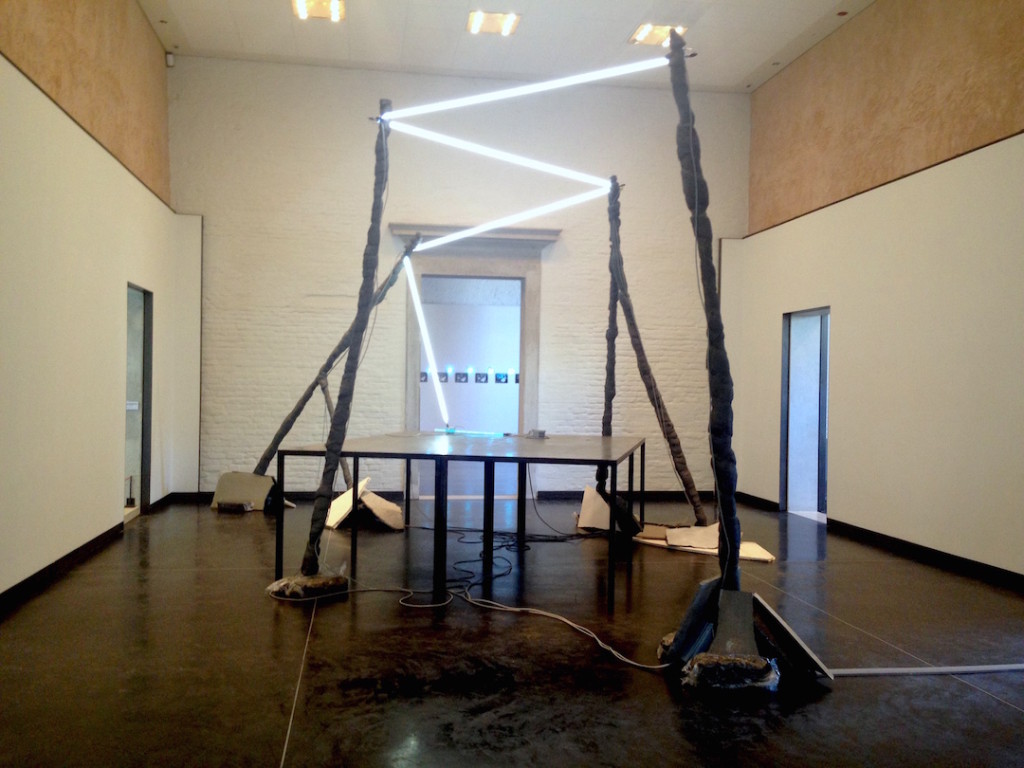
Mario Merz, “Fulmine in tazzina” (1990), Metal tables, bamboo, steel wool, coffee cup, neon, stones, clay, from the exhibition “Citta irreale”, Galleria dell’Academia, Venezia, Photograph by Katy Hamer, 2015
A rare opportunity to view works by Mario Merz (1925-2003), were included in an exhibition titled “Citta irreale” at the Galleria dell’Accademia in Venice. Having spent time in the floating city, Merz made work reflecting this unusual atmosphere and curator Bartolomeo Pietromarchi in collaboration with the Fondazione Merz, was able to transpose a sense of lightness and current through the not overly installed exhibition. Requiring ample room, the artworks were granted just that. Merz, one of the founding members of Arte Povera is still not often exhibited in the US and this exhibition presented a few gems that in particular functioned as a reminder of why he was so important to not only contemporary art, but also to the 1960s and 1970s. Two pieces stood out more than the others, “Impermeabile” (1966), a wall hung sculpture made of a raincoat, neon light, wood and wax along with “Fulmine in tazzina” (1990) consisting of metal tables, bamboo, steel wool, a coffee cup, neon, stones and clay. Merz, was a painter of portraits who never once used a figure or paint for that matter. His sculptures talk about the body: how we live, what we eat, how we move, and the duration of a lifespan. He does this by using objects, some manmade such as a raincoat and coffee cup, others, constructed bodies or rather things that assume to be ethereal references of flesh (steel wool), bone (bamboo/metal), neon (blood), and stones and clay (earth). Part of Merz’ oeuvre includes a multitude of igloos he built almost always the same height and circumference yet of varied materials. Are these to reference the concept of home or shelter? They often are accompanied by the Fibonacci number sequence, another notation alluding to time, in this case, infinity as well as cycles of nature. The sculptures included in “Citta irreale” had a different palette than some previous examples. The neon blue seemed to glow brighter, next to grey, black, and soft white, a coolness transpired even in the circumstance of warm temperatures plaguing Venice during the spring and summer months. While that coolness exists in the color palette it is far from the central underpinning running through the core of Merz’ work. Rather than feel detached, the sculptures are incredibly inclusive tapping into the metaphysical as well as the corporeal of existence and death. Curator Pietromarchi utilized not only the interior of the lower level galleries of the Accademia but also the outdoor courtyard where several skeletal igloos made of curved metal stood as relics in the otherwise whitewashed, stone constructed exterior. Standing in the center of one of these shells, enough room for me to be fully erect and comfortable, I felt the energy of the past, invisibly oozing from the stones, carried by warming rays of the sunshine. It was all trapped within the mystical construct before entering the body it is the body. Merz made work that captured something not many artists can capture, “Citta irreale” was a perfect representation of a city and it’s inhabitants without relying on architecture, narrative or the actual portrayal of something everyone would recognize.
Mario Merz, “Citta irreale” was on view May 8 to September 20 2015 and then extended to November 22nd, 2015.
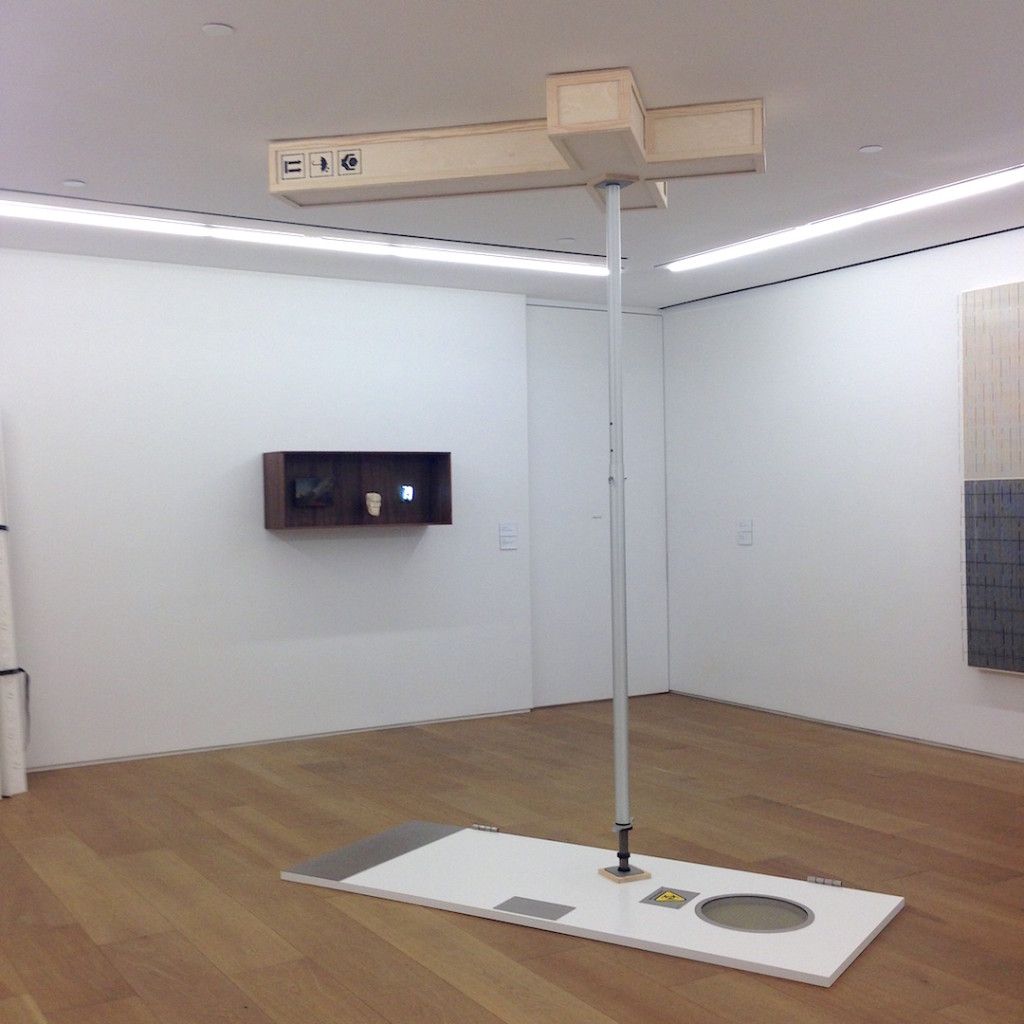
Elmgreen and Dragset, “Suspended (Heritage)” (2015), Detail of installation (Cross/Barre/Door) from “Past Tomorrow”, Galerie Perrotin, New York, Photograph by Katy Hamer, 2015
Artist duo Elmgreen and Dragset have been working together since 1995. For their exhibition at Galerie Perrotin in New York, “Past Tomorrow” they resurrected the living space of a fictional architect who they invented in 2013 for an exhibition at the Victoria and Albert Museum in London named Norman Swann. The entire street-level gallery was transformed into the bedroom of Mr. Swann and if one hadn’t been to Perrotin’s New York location, he or she would have been shocked by the drastic metamorphosis. The walls were painted a deep maroon and a four-post bed was the central focus. The artists had photographs on the walls, books that Swann would have enjoyed and a drawing table with never realized plans. Even though there was an unspoken sense of nostalgia and perhaps even melancholia present in the room, there was also an inviting warmth that was familiar and charged the space. A golden cast vulture, another character which appears in many of the duo’s recent exhibitions, sits, watching over the orchestrated scenario and with a title like “The Critic” its presence was a bit menacing.
In the lower level of the gallery, a series of works —possibly unrelated— were on the walls and one free-standing sculpture that, in particular, caught my eye. A very simple composition, the work consisted of a door on the floor from which extended a pole connecting to a boxed cross, flush against the ceiling. Seemingly, part of their “Powerless Structures” series, the piece was incredibly simple yet strong. Thrusting the unglorified cross against the ceiling (nearly into the room of Norman Swann just above), the shape is heavy yet appears light. In a simple gesture, it questions our own degree of faith, not only in the sculpture presented but in a grander schema. When an artist is able to tell a story that gives insight to a larger framed vision, we can grasp it or let it go. Either way, “Past Tomorrow” pointed a finger, not necessarily accusatory or pleasant, at political, religious and domestic situations all ripe for blame or praise.
ELMGREEN & DRAGSET “Past Tomorrow” was on view at Galerie Perrotin, New York from April 16 – May 23, 2015.
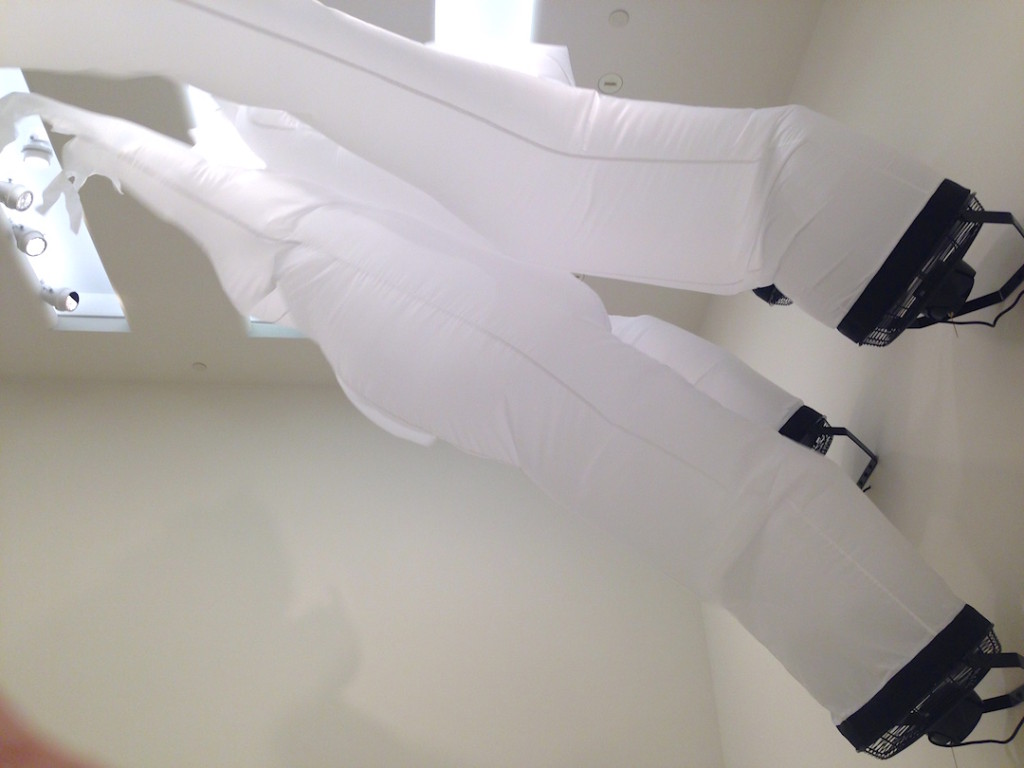
Paul Chan, “Tetra Gummi Phone” (2014-15) a piece made of nylon fabric and fans, “Non Projections for New Lovers”, Guggenheim, New York, Photograph by Katy Hamer, 2015
Paul Chan was the recipient of the Hugo Boss Prize for 2014. As part of the prize, he was given the opportunity to exhibit at the Guggenheim and he presented, “Nonprojections for New Lovers”, in one of the galleries off of the central rotunda. I wrote about the exhibition for W Magazine and did an interview with Chan which is featured in its entirety here. What more can be said about this exhibition? Well, I liked not only the visual simplicity of the installation, the element of ghosting brought on by the billowing fabric at the far end (shown above) as well as a series of singular shoes, weighted by cement and connected to projectors by one wire. The projectors are on yet not emitting images. They function yet do not contain or provide what we assume they will within their usual function. As part of the deeper exploration of ‘projection’, the artist also chose this exhibit to release three books from a series of erotic fiction released by his publishing house Badlands Unlimited, titled: How to “Train Your Virgin” by Wednesday Black, “We Love Lucy” by Lilith Wes and “God, I don’t even know your name” by Andrea McGinty. The book series is expanding and currently three additional stories are available for purchase on the Badlands Unlimited website.
I love the concept of a book as sculpture, whereas if it weren’t for words and pages, it would not be complete or as it is intended to be. Each reader, even here now, is able to project images from the text they are absorbing through black and white letter combinations, that sense of projection is both personal and universal. What do you have projecting in your mind now?
Paul Chan, “Nonprojections for New Lovers” was on view at the Guggenheim in New York from March 6–May 13, 2015.
Ylva Ogland is a painter currently based in Stockholm, Sweden. For a period of years, she and her husband resided in New York and were the Oracle and Keeper, respectively, of the Fruit and Flower Deli, an eclectic gallery that was in the Lower East Side. For “She in Four Acts” which was on view from April 22nd through July 26th, Ogland took over the entire expanse of the Bonniers Konsthall with a series of paintings in various stages of completion. Throughout the duration of the exhibition, the artist was working in the museum, turning the exhibition into a performative act, by using the space as her studio. Where this was most effective, was when the images which the artist was working on, were obscured or difficult to see. Art can pretend to be easy, but it never is. Here, the visitors were challenged to peer between canvases and circular holes cut into several large canvases. The paintings were numerous and representational of rather personal subject matter, including the birth of one of her two daughters. In one of the galleries, a series of at least 28 paintings stood on easels facing away from the viewer. Each painting, the same (with varying degrees of difference in brush stroke, subtle changes colorations) featured the artist, nude, frozen in a moment immediately after giving birth, blood trickling from her vaginal cavity. The sheer number of these works is a lot to take in and the subject,while conventional, not for the faint of heart. It is for this reason that the work stands out, it is both inviting and stand-offish, allowing for those present to peek into what was an intimate moment, yet also feel shunned as each canvas turns (away) back. There is a dichotomy present in which the artist begs for privacy and to be seen in the same instance. It is in this polarity where the exhibition was the most successful having implicated those present for wanting to lean in, for wanting to see and be part of the intimacy, so near and yet obscured.
The Bonniers Konsthall is currently closed due to renovations but will reopen in the spring with two exhibitions slated for 2016. The first will celebrate 30 years of the Maria Bonnier Dahlin Foundation and the second opening in September is called Insomnia. I also wrote a review surrounding the performative gesture of “She is Four Acts” that is in the October 2015 issue of Modern Painters.
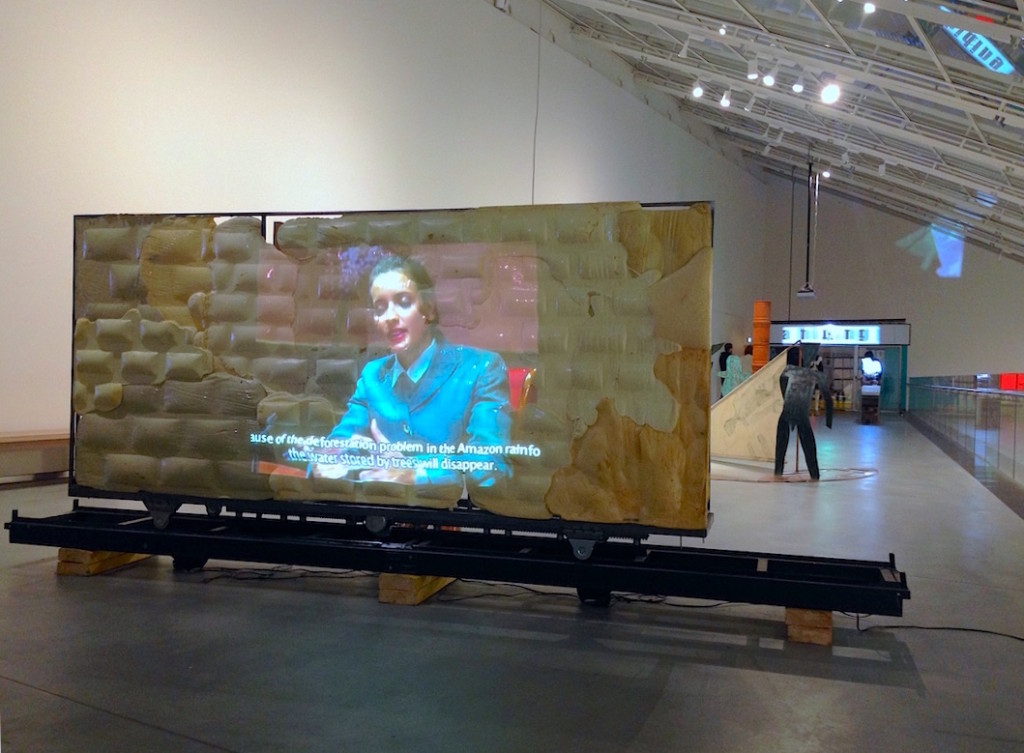
Neil Beloufa “World Domination Theatrical Release” (2014) in Europe, Europe at Astrup Fearnley, Oslo, 2015, Photograph by Katy Hamer
Focusing on Europe as an entity, hence the title “Europe, Europe“, this exhibition at the Astrup Fearnley in Oslo technically opened in 2014 but was on view through early January 2015. Curated by Hans Ulrich Obrist, Thomas Boutoux and Gunnar B. Kvaran, the group exhibit focused on artists under the age of 35 years old. The curators chose eight European cities and from those cities, two artists each, a Correspondent and an artist run venue to be represented from each city. Bringing into question ‘what is an art capital?’, the cities selected included Berlin, Brussels, Paris, London, Zurich, Prague, Lisbon and Oslo. It could be said that each of these cities is representative of a particular contemporary art scene and actually quite relevant within the art world. From these particular cities, two additional artists were chosen by the Correspondent from each of the selected cities resulting in 30 artists. Logistics and numbers aside, walking through the exhibition was almost like flipping the pages of a glossy magazine, something that fictionally might be called “Art Today: Europe”. Most of the artwork was slick and neatly installed. However, rather than feel at all dull, it cracked open an egg of dialogue, running, fluidly from piece to piece presenting a selection that was both thoughtful and timely. Several of the stand-out artists included Neil Beloufa (France), Ed Atkins (England), Simon Denny (Germany), Camille Henrot (France), Hannah Weinberger (Switzerland), and they might also be considered to be some of the top young contemporary artists working today.
Focusing on the unity of Europe through the European Union, allowing for cultural and educational mobility, “Europe, Europe” didn’t have an aesthetic focus, rather took inspiration from the concept of movement and cultural production in a Post-Internet age. Using sculpture, installation, painting and video the realization of language —both visual and text-based— functioned as a binding element of sorts, merging the various lingual accents. While the mother tongue was present in certain instances, English dominated, taking on the role of universal glue, where everything may or may not overlap. Still, all that being said, form won over function. Works such as Beloufa’s “World Domination Theatrical Release” (2014), a constructed motorized wall on a short section of track with a projected political-themed video, Simon Denny’s mixed media installation “New Management” (2014) focusing on corporate sponsorship, technology, and the presence of the virtual in real space, and Henrot’s “The Descendants of Pirogues” (2013) a canoe made of fiberglass holding sculptural elements made of ceramic installed through a free-standing wall, demonstrated an impossibility yet aesthetic beauty. Much like the plight of migrants moving from one country to the next “Europe, Europe” was at times problematic (some work stronger than others) but for the most part, a melting pot of sorts and like Europe, culturally enriching.
“Europe, Europe” was open to the public from September 18th, 2014 through February 1st, 2015 at the Astrup Fearnley, Oslo.
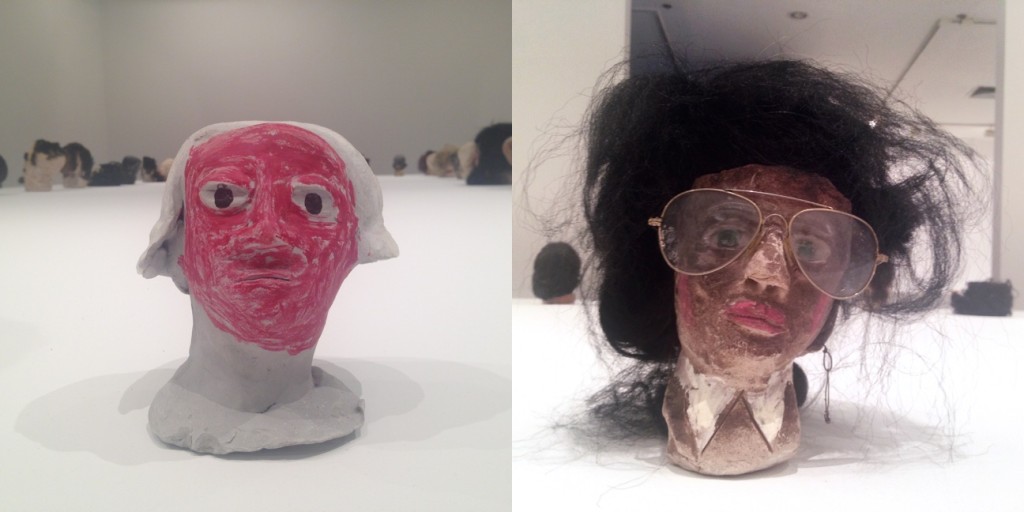
Sculptures from the installation at 80WSE Gallery, New York University, NY, Photograph/s by Katy Hamer, 2015
Most art comes from a place of obsession and such was the case of James ‘Son Ford’ Thomas (1926-1993) a blues musician, grave-digger and sculptor. The Mississippi born artist didn’t have a solo show in an institution prior to “James ‘Son Ford’ Thomas: The Devil and His Blues” since his death in 1993. Organized by Jonathan Berger, Mary Beth Brown, and Jessica Iannuzzi Garcia, along with NYU curatorial praxis students Jason Chau, Chia-Yin Chen, Alexandra Goullier, Marion Guiraud, Jaclyn Levy, and Tonya Monique Blazio- Licrorish the exhibition was on view at New York University, 80 Washington Square East Gallery. Featuring 100 of the artists unfired clay sculptures and two documentary films about his life, “James ‘Son Ford’ Thomas: The Devil and His Blues” brought these fascinating busts to public view. Having a hands-on appearance, the objects, still occasionally dusty from years of storage, were made of molded clay and still have remnants of finger prints from the artist. Thomas had an entire collection of characters that he made ranging from fictional to political. At the gallery, the sculptures were placed on expansive podiums relatively five feet tall bringing these odd faces and the viewer in this case me, nearly eye to eye. The heads, could be described as expressionless but do have, in fact distinct personality. Their eyes gaze is forward facing, sometimes with painted eyes and other times with marbles pressed into clay sockets. On some of the female subjects, tint has been placed on the lips and cheeks, real human hair on their heads. Several busts depicting George Washington stared ahead blankly, fluffy cotton hair atop of the molded heads. Another favorite subject of Thomas was skulls. Several of the skull depictions (including some of the other busts) shockingly had real teeth and tinfoil in the eye sockets. According to the press release many of the objects were made to have uses including to function as pencil holders and ashtrays and at least one in the gallery had tinfoil in the mouth, just waiting for ash. They were almost comical but also somehow incredibly endearing. We are so used to be told what art is and in this instance, we were shown. The James ‘Son Ford’ Thomas exhibition wasn’t only historically relevant, but also refreshing. So much of what we look at is polished and made to be. This work is naïve yet purposeful, narrative and nearly illustrative demonstrating people of importance from Thomas’ life along with imaginary faces. As a grave-digger for ten years, he dug deep into the clay dense soil faced with the relevance of death on a daily basis. Several of the sculptures also produced miniature coffins and figures inside, the artist’s signature across the front, seemingly predicting his own demise. Instead, he just used a bold, scribbled font to sign each of his artworks, proudly identifying the hand who made them.
Now in a state of fragility due to their age, being witness to these works, made by soil of the south, was a rarity especially in an urban jungle such as New York City. Didactic and absurd at the same time, the presence of these odd sculptures in such large quantity were a fitting reminder of time, touch and function as an important marker in cultural significance of African American art.
James ‘Son Ford’ Thomas: The Devil and His Blues” was on view at 80WSE from June 9th through August 7th, 2015.
What happens when you not only merge the present with the past but overlap it? The curatorial team at the Munch Museum were game to find out. Calling on one of Norway’s most visible contemporary artist, Bjarne Melgaard, the museum brought together the paintings of the eponymous namesake of the museum Edvard Munch and Melgaard, a bad boy of sorts in the art world. As was to be expected, the press in Norway were for the most part, not amused by this unlikely (but not really) pairing. Both Munch and Melgaard tend towards shining a light on the dark side of humanity. Where they differ is in palette. Munch, a moody, shadow-filled painter looked towards the cloudy day, dusk, and heartbreak for his inspiration while Melgaard, while similarly inspired, often uses really bright colors to communicate a darker current that runs just below the surface. However, that said, the pairing makes sense, but was incredibly bold, admirable and for that matter memorable. I can’t think of any museum in the world that would be willing to cover one of their national masterpieces and that is exactly what the Munch Museum allowed Melgaard to do. I will never forget the moment that Tim Smith, Melgaard’s manager, asked me if I had seen the fated “Scream” by Munch while walking through a preview of the exhibition. Upon saying no, he lead me to a low hanging, framed photograph declaring, “Here it is.” My jaw dropped momentarily and then a sly smily crept across my face, even though a feeling of incredulousness took over. Laid over the framed glass covering an 1893 pastel version of the “Scream” part of the museum’s permanent collection, was a printed photograph, Melgaard’s ‘scream’, a screenshot of someone dying in a snuff film.
The rest of the exhibition was nearly a blur after that. Artworks hung on the wall, the surfaces becoming fodder for what was a large-scale collage. The artists work was layered one on top of the other, sharing the responsibility of agency. The most obvious, direct relationship between their works is found in Melgaard’s “Untitled (Couple)” from 1997 where he makes direct reference to Munch’s “Kiss” from 1897. Other than that it was as if Melgaard took a page out of Munch’s book..and then scribbled all over it. The past cannot repeat itself but it can still have the strength to shock if given that capacity. As Bjarne Melgaard walked through his exhibition, admiring his sculptures of skater rat punks, self-portraits, canvases splayed with rag dolls, and a video (Gym Queens Deserve to Die, 2000) it wouldn’t have been shocking if upon squinting, Edvard Munch’s ghost was right there with him, even holding his hand.
Melgaard + Munch, The End of it All Has Already Happened, curated by Lars Toft-Eriksen was on view at the Munch Museum in Oslo from January 31st through April 12th, 2015. I also wrote a review of this exhibition for Flash Art International.
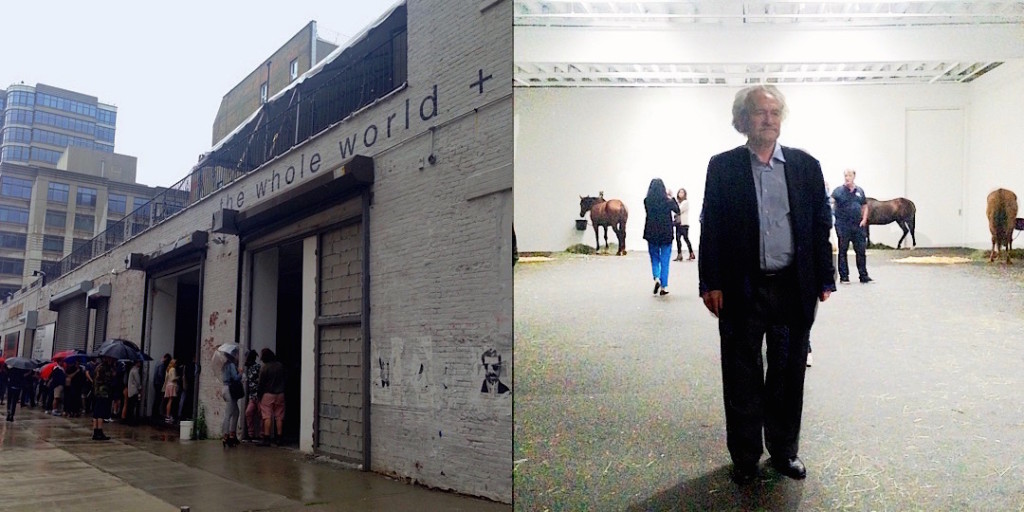
Jannis Kounellis, “Untitled (12 Horses)” at Gavin Brown Enterprise in Greenwich Village, NY, 2015, Photograph/s by Katy Hamer
In June, upon deciding to close his Greenwich Village gallery in favor of seeking out a new space, Gavin Brown’s Enterprise presented as a farewell of sorts, by exhibiting “Untitled (12 Horses)“ (1969) by artist Jannis Kounellis. This was the first time the installation was shown in the United States as it was only previously exhibited in Rome, in 1969. Featuring, as the title suggests, 12 Horses tied to the interior wall of the gallery, groomed and fed, the work is a bit ridiculous, fantastical, unexpected and very much from the time of Arte Povera. Having live animals as a medium within the context of art, allows for one to reconsider, not only what art is, but where it can exist and how it is truly bound to the artist and his or her intention. Also as part of the exhibition was a work by Rirkrit Tiravanija (free pork tacos and beer) along with a video by the late Sturtevant’s, projected in the gallery after the horses were brought home for the evening. The exhibition not only attracted large crowds (lines that extended well beyond the length of the gallery) but also as art can do, raised awareness, caused some controversy and while doing both also remained quite still. I spoke to Jannis Kounellis at the exhibition (huge moment for me) and our brief dialogue (translated from Italian) is below.
Katy Diamond Hamer: Congratulations on the new iteration of this exhibition. Can you speak on the differences from the 1969 version versus how it exists today?
Jannis Kounellis: Thank you. It is completely different. There isn’t this sense of wonder, around a humanistic civilization and the [major] distinction is that. Then the rest is in part to the mindset that we have now, Americans included, everyone, but here, the show is completely different.
KDH: The second time I saw your work in person was at the Centro per l’Arte Contemporanea Luigi Pecci in Prato, 2003. It has remained burned into my memory because of the large pieces of cow meat hanging on the walls of the space. I remember speaking to a gallery attendant who said that the meat needed to be replaced every few days to prevent a smell. This wouldn’t be possible in the United States so it was special to see.
JK: It isn’t possible to have actual contact with them. They, [the slabs of meat] are some paintings that are monochromatic and what does it mean to be monochromatic? I would say that it is a formal idea from God, the concept of monochome. But God without Christ, while here Christ is said to be God, the difference is just that. We also have great pagan civilizations that first entered into Christian society and then expanded everywhere. The imagination [between the two] is only slightly different. Slightly because they are both part of Western viewpoint.
…………………………………………………………………………………………………………………………
Art is God.
Kounellis, Sturtevant, and Tiravanija was on view from June 24th through June 27th, 2015 at Gavin Brown’s now shuttered, West Village location. Stay tuned for a promised move to Harlem and for now be sure to visit the smaller gallery located at 291 Grand Street in the Lower East Side.

Just what the doctor ordered. A prescriptive performance at a rooftop party in Greenpoint, Photograph by Katy Hamer, 2015
At a rooftop party held this summer in mid-July, artist Sol Kjøk now part of the Last Frontier NYC and previously the Founding Artistic Director of NOoSPHERE, hosted friends, colleagues and other artists. Video was projected onto a nearby brick façade, a dj played danceable tunes, and a duo who go by ReFemme, met with patients in an unassuming white tent, set up near the revelers. Even if it didn’t necessarily look that interesting to me initially, I was intrigued enough to put my name down on a list and see what was going on within the otherwise private tent. Sure enough, when my name was called, I entered and was asked several questions about how I was feeling. The two women exhibited a very specific ‘doctor-like’ movement, and proceeded to look in my eyes, my ears, take my blood pressure and listen to my heart. They spoke in soft, whispery voices, nearly mimicking the experience of ASMR but in real life. As they asked questions and performed this simple examination, they became quite complimentary. They looked at my eyes through a magnifying glass, commenting that they were the most beautiful eyes they had seen and predicted that if I change the way I think about or see myself that good things are in store and many of them I already have. This was a lovely suggestion in an unexpected environment. At one point they asked to read my aura and asked me to exhale in one deep blast, onto a mirror. They read the aura and were very complimentary. At the end of the exam, they spoke quietly to each other and filled out a prescription. Handing it to me they suggested I follow their prescription on a daily basis being sure to take it at least once a day. Looking down to see what was now in my hand I read “You Are Perfect!”
How lovely that in a busy, competitive city that never sleeps, on a rooftop, under the moon shining over Greenpoint, I was reminded through this simple performative gesture that I’m more than OK.
Thanks to the ladies at ReFemme and Happy 2016 to all!
More soon
xo

